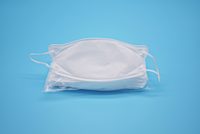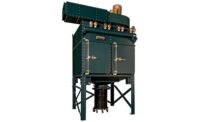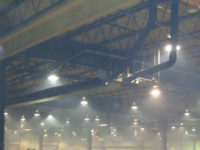Capture airborne particles to protect worker health








In welding operations, controlling airborne dust and fumes is crucial to prevent respiratory problems in employees and to keep facilities in compliance with air quality requirements.
Air pollution
Air is vital to our existence, and humans begin to physically struggle after only minutes without oxygen. Each day we breathe in about 2,000 gallons of air. The World Health Organization (WHO) has studied air pollution around the world and has developed guidelines based on particulate matter (PM). PM affects more people than any other pollutant.
Smaller particles with a diameter of 10 microns or less (≤ PM10) can reach the respiratory ducts, while particles 2.5 microns or less (≤ PM2.5) can lodge deep inside the lungs. Particles with a diameter of 1.0 microns or less (≤ PM1) can cause much more damage, because they can penetrate the lung barrier and enter the blood system. Regular exposure to PM contributes to the risk of developing respiratory diseases and even lung cancer. Many of the particles produced by welding reside within this range.
Who regulates what? National, state and local
Protecting people
OSHA’s General Duty Clause, Section 5(a)(1) stipulates that it is an employer’s responsibility to identify and abate hazards in the workplace. OSHA requires employers to keep records that identify all the dust generated in their facility. If the dust is flammable or explosive, then NFPA standards are followed to manage the dust.
OSHA has set permissible exposure limit (PEL) thresholds for metal contaminants generated by welding processes. If air quality testing shows that your facility is no longer meeting OSHA exposure limits for the materials you are welding, you are exposing your workers to dangerous fumes. OSHA has established PELs based on an eight-hour time-weighted average (TWA) for hundreds of dusts, including metals contained in welding fumes. They are listed in OSHA's annotated PEL tables.
Preventing combustible dust accidents
The National Fire Protection Association (NFPA) sets safety standards for managing combustible dust. OSHA, together with local authorities, enforces the NFPA’s combustible dust standards. OSHA issues fines and citations to facilities that do not comply with the NFPA’s standards. Most insurance agencies and local fire codes require companies to follow NFPA standards as code. Exceptions are made when the authority having jurisdiction (AHJ) accepts an alternative safety approach. AHJs can include city inspection departments (building, plumbing, mechanical) and local fire marshals/chiefs (who often make annual safety visits to facilities).
Protecting the environment
If visible fumes are exhausted outdoors, the air is subject to monitoring under EPA National Emission Standard for Hazardous Air Pollutants (NESHAP) Rule 6x. Within this standard are materials that contain 1.0 percent by weight manganese or 0.1% by weight cadmium, chromium, lead or nickel. Manganese is the material of widest concern to the welding industry, because it is a common component of welding wire. If you exhaust the air directly outdoors, you must take an EPA Method 22 Fugitive Emission test.
See the guidelines from OSHA, the National Institute for Occupational Safety and Health (NIOSH), the American Conference of Governmental Industrial Hygienists (ACGIH) and the California Division of OSHA for fumes and metals of concern for welding operations.
Successful systems to contain welding fumes
All welding operations will generate potentially dangerous fumes and particulates. These include manual flux cored arc welding (FCAW) and metal inert gas (MIG) welding, as well as robotic welding, robotic plasma cutting, manual cutting, arc gouging and laser cutting.
When it comes to creating a safe welding workplace, follow the three Cs of dust and fume removal: Capture, Convey and Contain. A dust collector designed specifically for your welding operation is an accepted and proven engineering control that can capture, convey and contain hazardous airborne contaminants. Dry media dust collectors containing high-efficiency cartridge filters along with secondary filters are the best control for respirable particulates.
There are three general types of fume collection systems for welding processes:
Source-capture systems are popular for applications involving small parts and fixture welding. Typically, they include fume exhaust guns (tip extraction), flexible fume arms and slotted fume hoods or small exhaust hoods with side shields. They are typically customized to be application-specific with minimal interruption of the workflow.
Enclosures and canopy hoods are often used where the footprint area is a medium size such as 12 feet by 20 feet or less. Curtains or hard walls may be added to the sides of the hood to create a booth or enclosure. In the case of robotic weld cells, a full enclosure over and around the application can often be used. This works well for single and dual welding robots and multi-axis plasma cutting robots, for example.
Ambient systems are used in larger areas at facilities involved in multiple operations to capture fumes. Large facilities can present challenges because of obstacles like multiple overhead cranes, fixed substructures for moving large parts and jib cranes for loading and lifting structures. In addition, large assemblies generate more fumes. An ambient system filters all the air in the shop using a central system or multiple smaller collectors.
When using an ambient system, keep in mind that fumes cannot be sucked in; rather airflow moves fumes. To illustrate this point, place a tissue on your desk about 18 inches away from you, then try to draw it towards you by taking a deep breath. Next, with the same proximity, blow the tissue across the desk.
That being said, ambient systems will help reduce hazardous dust, but they do not remove fumes from the breathing zone, so PPE may be required. Workers can use fans to direct fumes away from the breathing zone. Also, adjustable diffusers on supply outlets provide flexibility and control of clean air.
A few words about filters
Filters are the most important components in a dust and fume collector. Regardless of the type of collection system you use, when dealing with hazardous dust and fumes, you should also equip the system with a safety monitoring filter – sometimes called a final filter, secondary filter or after-filter. HEPA-grade filter media in a safety monitoring filter can achieve a dispersed oil particulate (DOP) testing efficiency of 99.97% on 0.3 micron particles.
A cost-effective, space-saving way of incorporating secondary filters is to select a dust collector equipped with integrated safety monitoring filters (iSMF). These secondary filters prevent collected dust from re-entering the workspace if the primary filter should become compromised. They can incorporate multiple styles of filters, including HEPA, when needed to obtain OSHA PEL levels.
Final thoughts
Creating a safe welding workplace for employees by filtering fumes and cleaning the air is top priority. You can achieve this by knowing the types of particulate matter that your operation generates, understanding the risks these particulates have on human health, following regulatory guidelines and selecting the right collection system and filters for your welding jobs.
Sources:
- How Your Lungs Get the Job Done, American Lung Association, https://www.lung.org/about-us/blog/2017/07/how-your-lungs-work.html
- Breaking Point: How Long Can Someone Go Without Breathing?, Medical Daily, https://www.medicaldaily.com/breaking-point-how-long-can-someone-go-without-breathing-364450
- Ambient (Outdoor) Air Pollution, World Health Organization, https://www.who.int/news-room/fact-sheets/detail/ambient-(outdoor)-air-quality-and-health
Looking for a reprint of this article?
From high-res PDFs to custom plaques, order your copy today!









